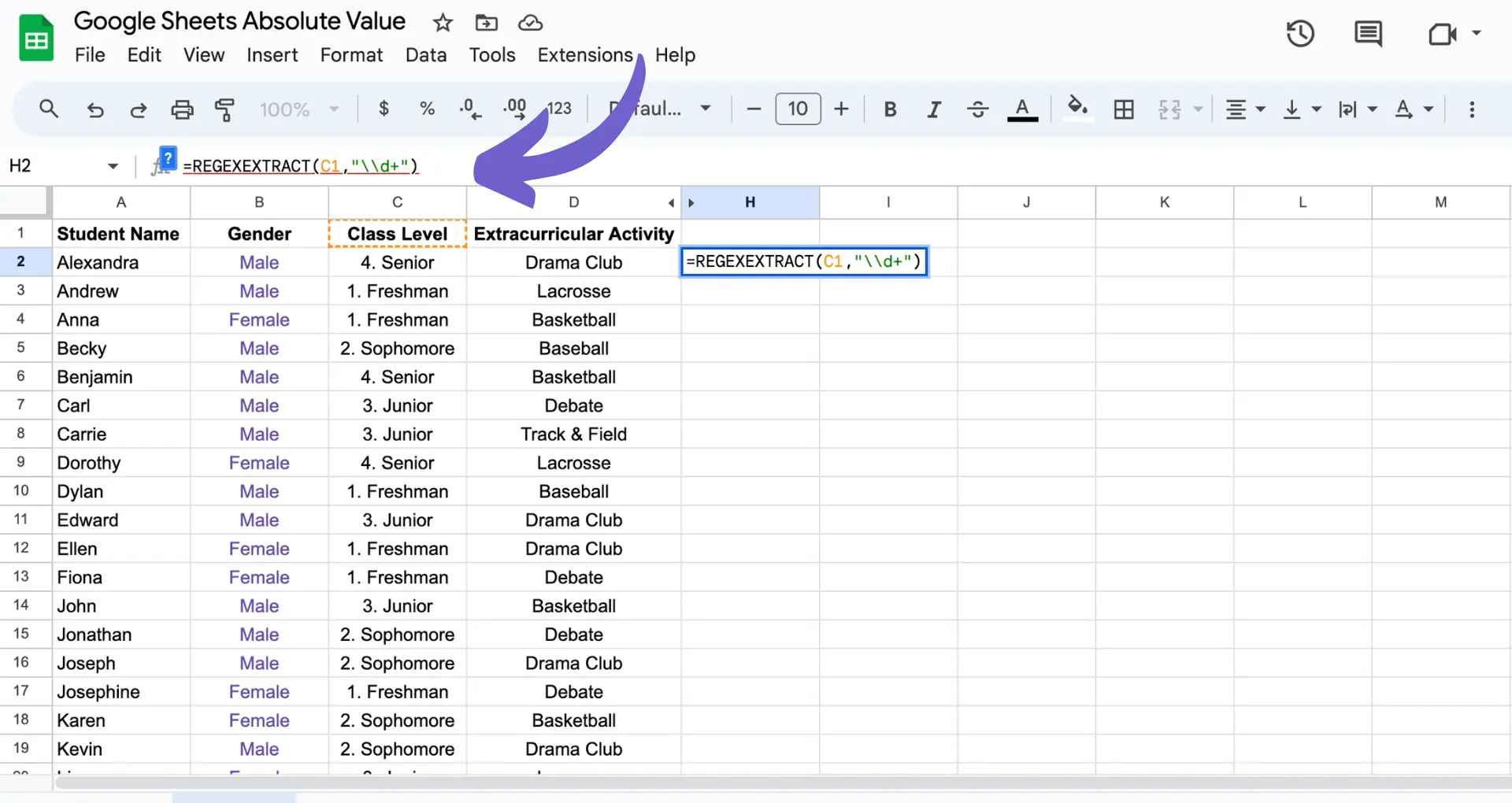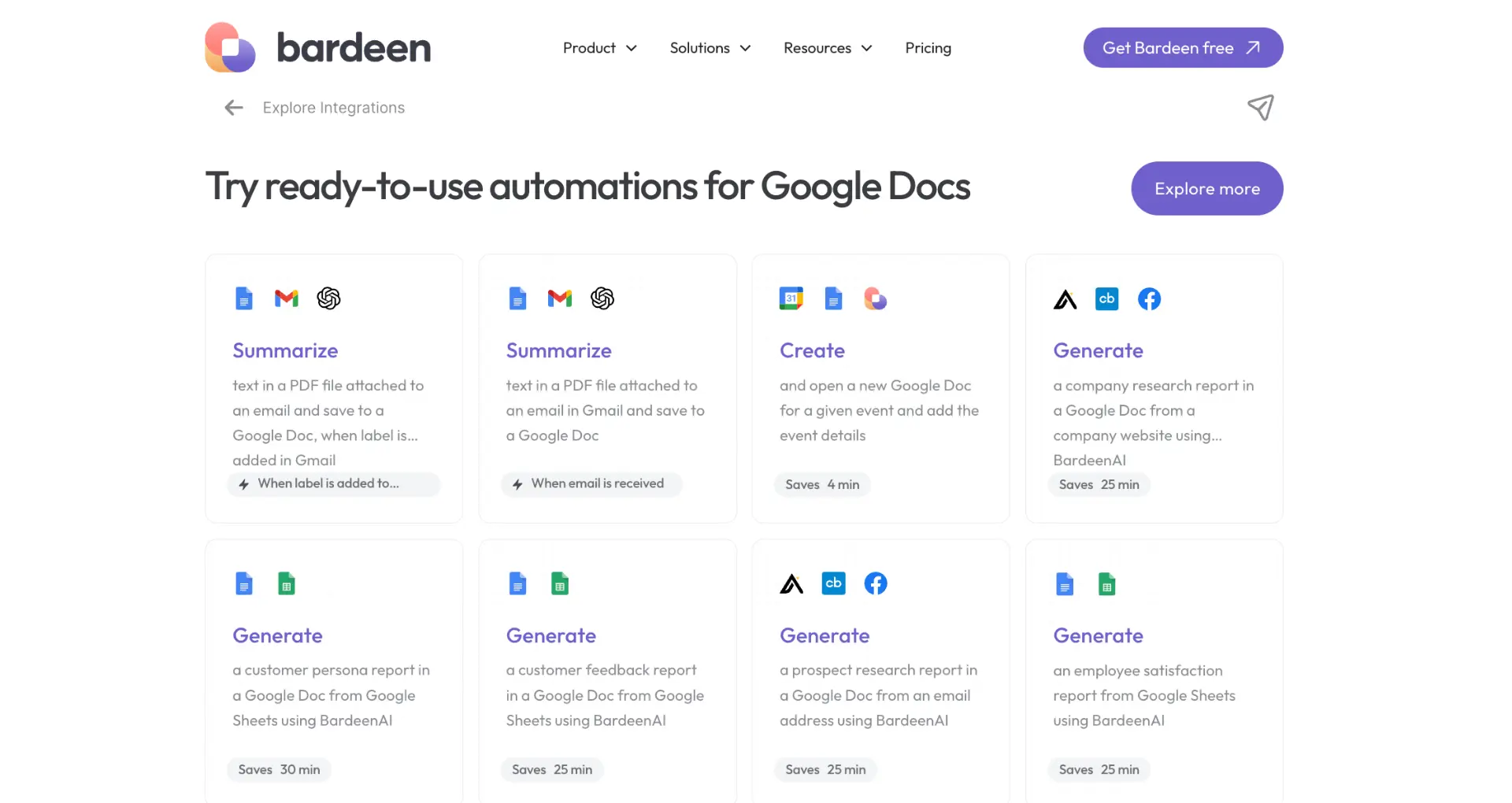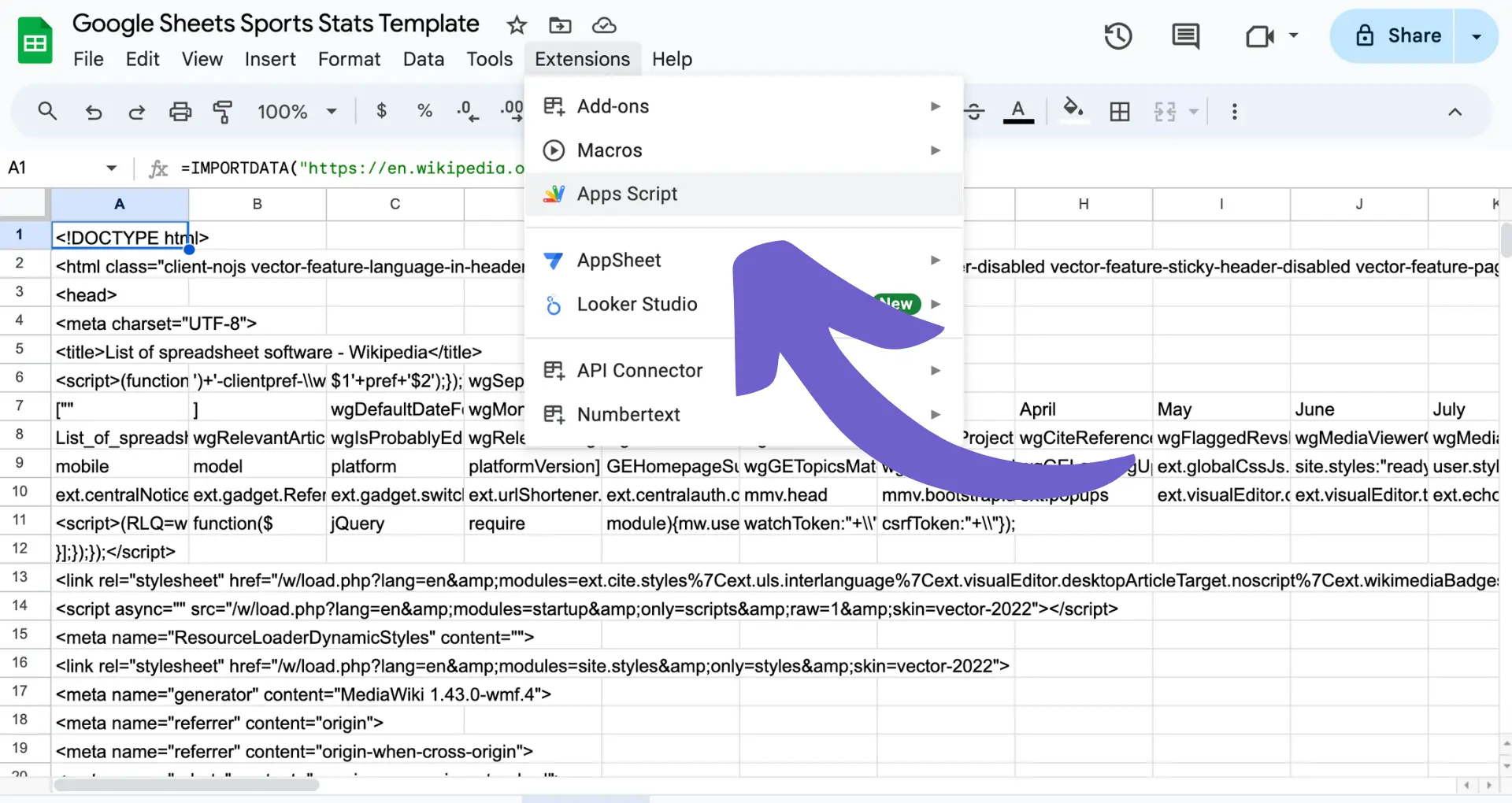Use REGEXEXTRACT to pull numbers from text in Google Sheets.
By the way, we're Bardeen, we build a free AI Agent for doing repetitive tasks.
If you work with data, you might find our GPT in Spreadsheets feature useful. It helps automate data extraction and analysis, saving you time.
Extracting numbers from text in Google Sheets is a crucial skill for data analysis and automation. With the help of Regular Expressions (REGEX), you can easily pull numeric data from complex strings, saving time and effort. In this guide, we'll walk you through the process of using REGEX functions in Google Sheets to extract numbers, from basic techniques to advanced applications.
Introduction to REGEX in Google Sheets
Regular Expressions (REGEX) are powerful tools for working with text data in Google Sheets. REGEX allows you to search for specific patterns within strings, extract matching data, and even replace or manipulate text based on those patterns. This makes it invaluable for data cleaning, validation, and analysis tasks.
The importance of extracting numbers from text using REGEX in Google Sheets cannot be overstated. Whether you're working with financial data, inventory records, or customer information, being able to quickly and accurately pull numeric values from complex strings can save countless hours of manual effort. GPT for Google Sheets can enhance this process.
Some key applications of REGEX for number extraction in Google Sheets include:
- Extracting dates or ID numbers from inconsistently formatted entries
- Pulling prices or quantities from product descriptions
- Validating data by checking for the presence or absence of numbers
- Cleaning up phone numbers, ZIP codes, or other numeric data stored as text
By mastering REGEX techniques for number extraction, you'll be able to tackle a wide variety of data preparation and analysis challenges in Google Sheets with confidence. For more advanced tasks, consider using a web scraper extension.
Understanding Key REGEX Functions
Google Sheets offers three primary REGEX functions to manipulate and extract data: REGEXMATCH, REGEXEXTRACT, and REGEXREPLACE. Each function serves a specific purpose in working with text strings and patterns.
REGEXMATCH tests whether a given text matches a specified regular expression pattern. It returns TRUE if a match is found anywhere in the text, and FALSE if no match is found. For example:
=REGEXMATCH("Hello World","Hello")returns TRUE=REGEXMATCH("Hello World","Goodbye")returns FALSE
REGEXEXTRACT allows you to extract a portion of text that matches a regular expression pattern. It returns the first matching substring. If no match is found, it returns an #N/A error. For instance:
=REGEXEXTRACT("The price is $99.99","\\$\\d+")returns "$99.99"=REGEXEXTRACT("The price is $99.99","\\£\\d+")returns #N/A
REGEXREPLACE replaces all occurrences of a regular expression pattern in a text string with a specified replacement string. It's useful for cleaning up or reformatting data. For example:
=REGEXREPLACE("Call us at 555-1234","\\d","*")returns "Call us at ***-****"=REGEXREPLACE("John Doe","(\\w+)\\s(\\w+)","$2, $1")returns "Doe, John"

By leveraging these REGEX functions in Google Sheets, you can efficiently manipulate and extract data based on patterns, saving time and effort in data cleaning and analysis tasks. For more advanced tips, you can also integrate Google Sheets with Bardeen to automate repetitive tasks.
Save time on data cleaning with Bardeen. Use our tool to connect Google Sheets and automate repetitive tasks quickly.
Step-by-Step Guide to Using REGEXEXTRACT
REGEXEXTRACT is a powerful function in Google Sheets that allows you to extract specific parts of a text string using regular expressions. In this example, we'll walk through how to use REGEXEXTRACT to pull numbers from a mixed text string.
Suppose you have a cell A1 with the following text:
The total cost is $123.45, and the tax is an additional $12.35.
To extract the numbers from this string, you can use the following formula in cell B1:
=REGEXEXTRACT(A1,"[-]?\d+\.?\d*")
Let's break down the regular expression pattern:
[-]?: Matches an optional minus sign for negative numbers.\d+: Matches one or more digits.\.?: Matches an optional decimal point.\d*: Matches zero or more digits after the decimal point.
The formula will return the first number found in the string, which is "123.45". To extract the second number, you can use the following formula in cell B2:
=REGEXEXTRACT(A1,"[-]?\d+\.?\d*",2)The additional argument "2" tells REGEXEXTRACT to return the second match, which is "12.35".
By using capture groups in your regular expression, you can extract multiple values at once. For example, to extract both numbers in separate columns, use the following formula in cell B1:
=REGEXEXTRACT(A1,"([-]?\d+\.?\d*).*([-]?\d+\.?\d*)")This will return "123.45" in cell B1 and "12.35" in cell C1.
If you're looking to automate data extraction, consider using free AI web scraper tools for more complex tasks.
With this step-by-step guide, you can now use REGEXEXTRACT to pull numbers from mixed text strings in Google Sheets, including complex patterns like decimals and negatives.
Advanced Techniques with REGEXREPLACE
REGEXREPLACE is another powerful function in Google Sheets that allows you to replace parts of a text string based on a regular expression pattern. This function is particularly useful for cleaning and formatting data, such as removing non-numeric characters from strings.
Suppose you have a cell A1 with the following text:
The price is $123.45, but after the 20% discount, it comes down to $98.76.
To remove all non-numeric characters from this string, leaving only the numbers, you can use the following formula in cell B1:
=REGEXREPLACE(A1,"[^0-9.]","")Let's break down the regular expression pattern:
[^0-9.]: Matches any character that is not a digit (0-9) or a decimal point.
The second argument, "", is an empty string, which replaces all matched characters with nothing, effectively removing them.
The result in cell B1 will be:
123.4598.76
You can further refine the formula to include spaces between the numbers:
=REGEXREPLACE(A1,"[^0-9.\s]","")This will result in:
123.45 98.76
Using REGEXREPLACE to clean and format data can significantly automate data cleaning workflows and data processing. Some common scenarios include:
- Extracting numeric data from mixed text sources for analysis
- Standardizing phone numbers, dates, or other formatted data
- Removing unwanted characters or symbols from imported data
By mastering REGEXREPLACE, you can save time and effort in preparing your data for further analysis and reporting in Google Sheets.
Want to automate your data tasks further? Use Bardeen's automation to save time and focus on critical work.
Practical Applications of Number Extraction in Business Scenarios
Extracting numbers from text using REGEX functions in Google Sheets has numerous practical applications across various business scenarios. By automating the process of pulling numeric data from mixed sources, companies can streamline their workflows and gain valuable insights for decision-making.
One common use case is financial reporting. Suppose a business receives monthly sales data in a text format, with each entry containing the date, product name, and revenue generated. Using REGEXEXTRACT for phone numbers, the finance team can quickly extract the revenue figures and import them into a spreadsheet for further analysis, such as calculating total monthly revenue or identifying top-performing products.
Another application is inventory management. Consider a company that maintains a database of product information, including item codes, descriptions, and quantities in stock. The item codes often contain a mix of letters and numbers, making it challenging to sort and analyze the data. By using REGEXREPLACE to remove non-numeric characters, the inventory manager can easily extract the numeric portion of the item codes, enabling them to categorize products and monitor stock levels more effectively.
Customer data analysis is yet another area where number extraction proves invaluable. Many businesses collect customer information through online forms or surveys, which may include fields like age, phone number, and postal code. Enriching LinkedIn profiles using REGEX functions allows companies to segment their customer base, identify demographic patterns, and tailor their marketing strategies accordingly.
For example, a retail store might use REGEXEXTRACT to pull postal codes from customer addresses, enabling them to analyze sales trends by geographic region and optimize their inventory distribution.
In summary, the ability to extract numbers from text using REGEX functions in Google Sheets empowers businesses to:
- Automate financial reporting and analysis
- Streamline inventory management processes
- Gain insights from customer data for targeted marketing
- Make data-driven decisions across various departments
By leveraging these techniques, companies can save time, reduce manual errors, and unlock the full potential of their data to drive business growth and profitability.
Troubleshooting Common REGEX Issues
When working with REGEX functions in Google Sheets, users may encounter various issues that lead to unexpected results or errors. Here are some common mistakes and troubleshooting tips to ensure accurate results:
- Invalid REGEX syntax: One of the most frequent issues is using an invalid REGEX pattern. Google Sheets uses the RE2 syntax, which has some limitations compared to other REGEX engines. For example, RE2 does not support lookarounds or conditional constructs. Double-check your REGEX pattern and ensure it follows the RE2 syntax rules.
- Mismatched data types: REGEX functions in Google Sheets only work with text input, not numbers. If you're trying to use REGEX on numeric data, first convert the numbers to text using the TEXT function. This will prevent errors and ensure the REGEX functions can process the data correctly.
- Case sensitivity: By default, REGEX functions in Google Sheets are case-sensitive. If you want to perform a case-insensitive match, you can use the (?i) flag at the beginning of your REGEX pattern. For example, (?i)hello will match "hello", "HELLO", and "Hello".
- Escaping special characters: If your text contains special characters that are also used in REGEX syntax (e.g., ., *, +, ?), you need to escape them with a backslash () to treat them as literal characters. Forgetting to escape special characters can lead to unexpected matches or errors.
To troubleshoot issues effectively, break down your REGEX pattern into smaller components and test each part separately. This will help you identify which portion of the pattern is causing the problem. Additionally, use online REGEX testing tools to validate your patterns and ensure they match the expected results.
Bardeen can help you connect Google Docs and automate data extraction tasks. Save time by turning repetitive tasks into single-click actions.

Best practices for working with REGEX in Google Sheets include:
- Keep your REGEX patterns as simple as possible to improve readability and maintainability.
- Use comments within your formulas to explain complex REGEX patterns, making it easier for others (or yourself) to understand the logic later.
- Test your REGEX functions on a small sample of data before applying them to larger datasets to catch any errors early on.
- Regularly review and update your REGEX patterns as your data structures or requirements change over time.
By following these troubleshooting tips and best practices, you can minimize errors and ensure accurate results when using REGEX functions in Google Sheets.
Enhancing Data Extraction with Add-ons and Scripts
While the built-in REGEX functions in Google Sheets are powerful, there may be situations where you need more advanced capabilities or automation. This is where add-ons and Google Apps Script come into play.
Google Sheets add-ons are third-party extensions that provide additional functionality and features. Some popular add-ons for data extraction and manipulation include:
- RegexExtract: This add-on allows you to extract data from text using REGEX patterns without the need for complex formulas. It provides a user-friendly interface to input your data and REGEX pattern, making it easier for users who are less familiar with REGEX syntax.
- Advanced Find and Replace: As the name suggests, this add-on offers advanced find and replace capabilities using REGEX. It enables you to perform complex search and replace operations across multiple sheets and ranges, saving time and effort.
In addition to add-ons, Google Apps Script is a powerful tool for automating tasks and extending the functionality of Google Sheets. With Apps Script, you can write custom functions and scripts to handle complex REGEX operations and data extraction processes.
Here are a few ways you can use Apps Script to enhance your data extraction workflows:
- Custom REGEX functions: Create your own REGEX functions to handle specific use cases or complex patterns that are not easily achievable with the built-in functions. You can encapsulate the REGEX logic within a custom function and call it from your Google Sheets formulas.
- Automated data extraction: Use Apps Script to automate the process of extracting numbers or other data from text. You can create scripts that read data from a sheet, perform REGEX operations, and write the extracted data back to another sheet or range. This is particularly useful when dealing with large datasets or recurring extraction tasks.
- Integration with external APIs: Apps Script allows you to connect Google Sheets with external APIs and services. You can write scripts to send extracted data to other applications or retrieve data from external sources and apply REGEX operations before importing it into your sheets.
To get started with Apps Script, you can access the script editor by selecting "Tools" > "Script editor" from the Google Sheets menu. The script editor provides a development environment where you can write and test your scripts.
When integrating add-ons or scripts into your data extraction workflows, consider the following best practices:
- Test your scripts and add-ons thoroughly before deploying them to production environments.
- Use clear and descriptive names for your custom functions and variables to enhance readability and maintainability.
- Implement error handling and logging mechanisms to track and debug any issues that may arise during execution.
- Optimize your scripts for performance, especially when dealing with large datasets, to avoid slowing down your sheets or exceeding execution time limits.
By leveraging add-ons and Google Apps Script, you can take your data extraction capabilities to the next level, automating complex tasks and streamlining your workflows in Google Sheets. For example, you might enhance data extraction with web scraper extensions that automate your workflows.

Automate Google Sheets Data Tasks with Bardeen
Extracting numbers from Google Sheets can be a manual task requiring complex formulas or scripts. However, for those looking to streamline their workflows and automate data extraction and processing, Bardeen offers a suite of powerful automation playbooks. Whether you're dealing with large datasets, performing regular updates, or integrating data across platforms, Bardeen's playbooks can save you time and reduce errors. Automate your Google Sheets tasks to focus more on analysis and insights.
- Copy Google News for a keyword and save results to Google Sheets: This playbook automates the collection of Google News articles based on keywords and directly saves the results into Google Sheets. It's an efficient way to keep track of news trends or mentions without manual searches and data entry.
- Extract Emails from Google Search Results to Google Sheets: Perfect for lead generation and research, this playbook automates the extraction of email addresses from Google Search results and compiles them in Google Sheets, streamlining outreach and data collection efforts.
- Scrape Redfin Listings Contact Numbers to Google Sheets: Real estate professionals can benefit from this playbook by automating the extraction of contact numbers from Redfin listings into Google Sheets, facilitating an organized approach to lead generation and market research.






.svg)
.svg)
.svg)
